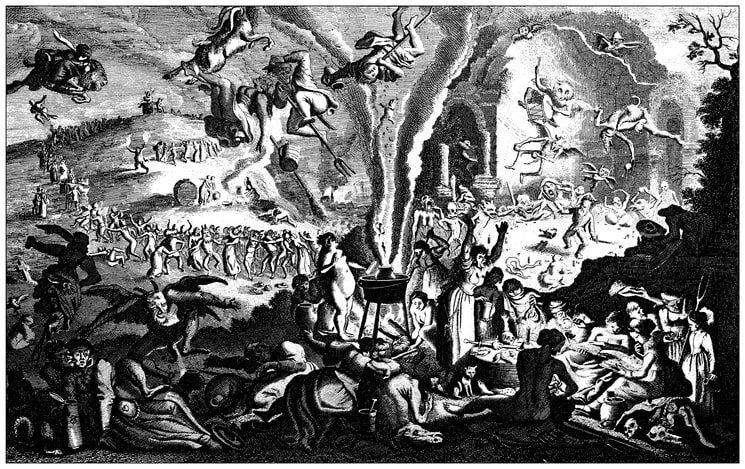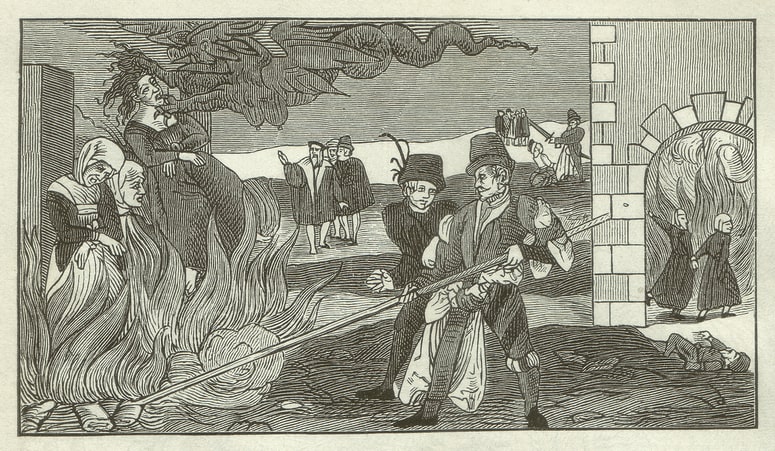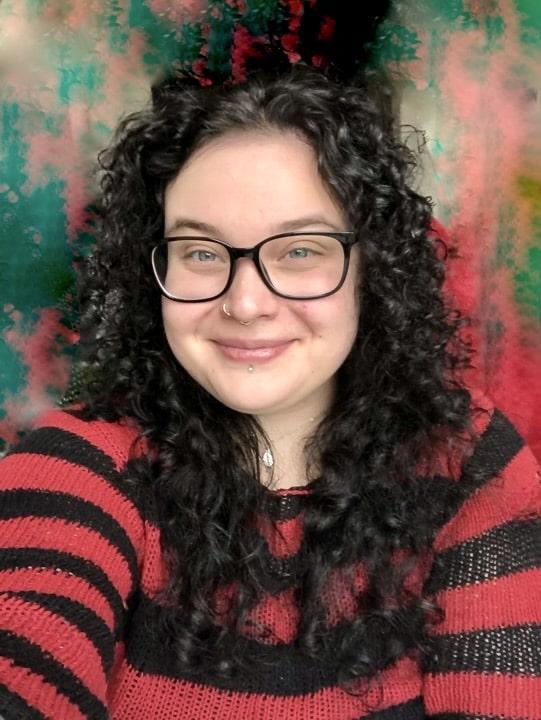The History of Witchcraft (& Witches!)


Witchcraft has been a topic of fascination and fear for centuries, and it goes far beyond the iconic image of an old woman flying on a broom or stroking black cats. The actual influence of witchcraft around the world has been undeniable and palpable throughout history!
From witch hunts to witch trials, the concept of witches and their supposed supernatural powers has captivated the human imagination and bled into various pop culture, media, and cultural phenomena. For example, the history of witchcraft continues to have an impact on modern culture, particularly during Halloween, which has its roots in ancient British and Celtic festivals. In this article, we will explore the history of witches and their craft, delving into various aspects such as witch hunts, witch trials, and the cultural impact of witchcraft beliefs. And while there is certainly evidence of male witches — or warlocks — we will focus on the impact made by female practitioners or those who were accused of such beliefs.
The Origins of Witchcraft
Witchcraft can be traced back to ancient times, with depictions of witches found in various mythologies and folklore, from Roman gods to Celtic deities. In Europe, witchcraft became associated with the devil during the Middle Ages, particularly influenced by the spread of Christianity.[1] As Christianity gained prominence, pagan practices were condemned, and individuals accused of practicing witchcraft were seen as aligning themselves with evil forces.
However, the belief in witchcraft predates Christianity. In ancient civilizations such as China, Mesopotamia, Rome, Egypt, and Greece, there were references to individuals who possessed magical powers and could communicate with spirits or deities.[2] These individuals were often revered as wise or feared as dangerous.
The concept of witchcraft was also deeply connected to nature and the spiritual world. Witches were believed to have the ability to harness natural forces and manipulate them for their own purposes. In many cultures, witches were associated with healing, divination, or protective magic. They were seen as intermediaries between humans and the spiritual realm.

The Protestant Reformation and Witch Hunts
The Protestant Reformation, which began in 1517 with the “Ninety-Five Theses” of Martin Luther, had a significant impact on the perception of witches and witchcraft in Europe during the early modern period. As the Reformation challenged the authority of the Catholic church, it also fueled religious tensions and fears surrounding supernatural practices.
During the Reformation, Protestant leaders and theologians condemned witchcraft as a form of sorcery associated with Satan. They believed that witches made pacts with the devil and used their supernatural powers to harm others. This perception contributed to the intensification of witch hunts and trials in Protestant territories, as well as fears stemming from the appearance of witches in the Bible.
The concept of witchcraft in the Bible, particularly in the Old Testament, played a role in shaping European beliefs about witches.[3] References to sorcery and witchcraft in biblical texts contributed to the widespread terror and persecution of supposed witches during this time, creating hysteria and havoc among many societal groups and communities.
As such, the fear of witches and their alleged connection to Satan and demonology became deeply ingrained in Protestant societies. The Protestant clergy played a crucial role in promoting and perpetuating this fear. They preached sermons warning their congregations about the dangers of witchcraft and actively participated in the identification and persecution of individuals believed to be involved in sorcery.
The Protestant Reformation also had an impact on the legal systems of European countries. Witchcraft was increasingly considered a crime against the state and was included in legal codes. Witchcraft trials became more standardized and systematic, with legal procedures guiding the prosecution and punishment of accused witches.
It is important to note that not all Protestants shared the same views on witchcraft. Some Protestant leaders, such as Johann Weyer, questioned the validity of witchcraft accusations and advocated for a more rational and humane approach. However, the overall impact of the Reformation on witchcraft beliefs and persecutions cannot be overlooked.
Witchcraft Around the Reformation
The notion of witchcraft as a religious and societal threat persisted long after the Reformation. The beliefs and practices associated with witchcraft continued to be condemned by both Protestant and Catholic authorities. The “Malleus Maleficarum”, or “The Hammer of Witches”, a treatise on witchcraft published in 1486 by Heinrich Kramer, gained renewed popularity during the Reformation and provided a guide for identifying and dealing with witches, for many would-be inquisitors.[4][5]
After the Reformation, Queen Elizabeth I's reign in England also coincided with a significant increase in witch trials, until her death in 1603. Accusations of witchcraft were prevalent, and individuals believed to be involved in witchcraft faced persecution and often execution.
During the rest of the seventeenth century, Europe experienced significant religious upheaval with the rise of Protestantism. The fear of witches and their alleged connection to Satan intensified, leading to witch hunts and trials in countries such as England, Spain, France, and Germany, often resulting in severe consequences for those accused of being sorcerers.
In cities like London, Oxford, and other populous parts of Britain, witchcraft trials were conducted to identify and punish those accused of practicing witchcraft.[6] Accused witches were subjected to harsh interrogation methods and faced severe consequences if found guilty — which most, unfortunately, were.

Salem: The Witch Hunts and Trials
One of the most infamous periods in witchcraft history was the Salem witch trials in colonial America. In the late 17th century, the town of Salem, Massachusetts was gripped by a frenzy of accusations and trials, resulting in the execution of several individuals accused of witchcraft.[7]
The Salem witch trials involved a series of hearings and prosecutions in 1692, predominantly targeting women. The hysteria began when a group of young girls claimed to be possessed by witches, which led to an intense search for magic wielders, with over 200 people being accused. Those on trial were subjected to unfair proceedings, where spectral evidence and hearsay were accepted as proof of guilt.
Ultimately, 20 people were executed, while others faced imprisonment or exile. The witch trials in Salem serve as a dark chapter in American history, highlighting the dangers of mass hysteria and the consequences of unfounded accusations.
The Evolution of Witchcraft
However, as society progressed, perceptions of witchcraft began to change. The Renaissance period saw a shift in attitudes towards witchcraft, with scholars and intellectuals questioning the validity of accusations and promoting scientific explanations for perceived supernatural phenomena.
In later centuries, witchcraft became associated with popular imagination, influencing literature, art, and entertainment across English, Spanish, German, and French cultures, among many others.[8] This can be seen through the popularity of book series like “Harry Potter” or TV shows like “A Discovery of Witches”.
Witchcraft in Different Cultures
Witchcraft beliefs were not limited to Western or continental Europe, spreading through Africa, Asia, the Pacific Islands, South America, North America, and the rest of the world. In African beliefs, for example, witchcraft played a significant role in traditional societies, often associated with supernatural powers and spiritual practices. Similarly, in other parts of the world, such as America and Scotland, witchcraft was deeply ingrained in unique beliefs and practices.
The specific rituals, spells, and traditions surrounding witchcraft varied greatly, reflecting the diverse communal and cultural contexts in which they emerged. Despite these differences, the common thread across these cultures was the belief in individuals who possessed magical powers and their ability to interact with the spiritual realm.
However, even in modern times, some countries still view witchcraft and magic as a dangerous pursuit, still performing witch hunts and persecutions that are heavily gender-biased.[9] Some of these countries where practitioners can be unsafe include Ghana and Nepal, among others.[10]

Modern Witchcraft and Wicca
In the 20th century, witchcraft experienced a resurgence with the emergence of movements like Wicca, neopaganism, and others. One of the most prominent today, Wicca is a contemporary pagan religious movement that promotes a modern form of witchcraft. It emphasizes nature worship, rituals, and the exploration of magical powers.
This religion has been rapidly growing since its inception in the 1950s and now has millions of devotees around the world. It even has covens (groups of witches) in many cities, which offer support and spiritual guidance to those who practice witchcraft.
What Is Wicca?
Wicca incorporates elements from ancient pagan traditions, folklore, and ceremonial magic. It follows a spiritual belief system that is based on reverence for nature, the worship of a goddess and god, and the practice of witchcraft.[11] Wiccans believe in the existence of divine energy that permeates the universe and can be harnessed through rituals and spells.
One of the core principles of Wicca is the belief in the interconnectedness of all living beings and the importance of living in harmony with nature. Wiccans view the natural world as sacred and strive to maintain a balanced relationship with the environment. They celebrate the cycles of the seasons through the observance of eight seasonal festivals known as Sabbats, such as the pagan holiday of Samhain. These festivals mark the solstices, equinoxes, and points in between, and they serve as opportunities for rituals, celebrations, and reflection.
Just a Touch of Magic...
The history of witches and witchcraft encompasses a vast tapestry of human beliefs, fears, and cultural dynamics, and has left an indelible mark on human history. From ancient times to modern-day practices, from the witch hunts of the past to trending Wicca interests, the allure of the supernatural and the quest for understanding the unknown continue to captivate our imagination.
By delving into the intricate threads of witchcraft, we gain insights into the resilience of cultural beliefs, the influence of religion, and the complex socio-historical factors that shaped this intriguing aspect of human history. Are you still intrigued by aspects of witchcraft and magic? Test yourself with a quiz on Worldwide Witchcraft Locations, or discover more about the Salem Witch Trials that forever changed the face of witchcraft in North America!
About the author









